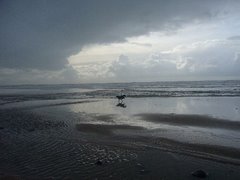
Laika was a Russian space dog which became the first living creature from earth to enter orbit. At one time a stray wandering the streets of Moscow, she was selected from an animal shelter. A good-natured 3 year old mongrel stray of calm disposition from the streets of Moscow, there is much speculation regarding Laika's ancestry. Some reports describe her as a Husky-mix or Samoyed-mix, almost certainly with strains of Spitz and Terrier in her bloodline, and it has even been suggested that one of her parents may have been a Beagle. After undergoing training with two other dogs, she was selected to be the occupant of the Soviet spacecraft Sputnik 2 and was launched into space on 3rd November 1957. Although Laika did not survive the trip, the experiment proved that a living passenger could survive being launched into orbit and endure weightlessness. It paved the way for human spaceflight and provided scientists with some of the first data on how living organisms react to spaceflight environments.
There is sufficient evidence to suggest that she suffered a horrible death both from stress and overheating. Her death was not made public until decades after the event. Her death would have been seen as a failure.
Her pressurized cabin within the spacecraft resembled an elongated ellipsoidal nest. The high walls were covered with soft padded material and there were intricate life support instruments positioned everywhere. Laika was secured in place with a special harness and had access to both water and food (a special high-nutrition gel) during the flight.
According to a NASA document, Laika was actually placed in the satellite on October 31, 1957, three days prior to launch from the Baikonur Cosmodrome (located NorthEast of the Aral Sea). She was carefully groomed...her coat sponged with a weak alcohol solution and then finely combed. Areas of her body where electrodes would be attached were painted with iodine and powdered with a streptocide. It was reported that Laika suffered no extreme ill-effects during the ascent and insertion into orbit since the electrodes recorded relatively normal vital signs under the circumstances, although she did seem somewhat agitated and her pulse rate did rise to three times its resting level. While weightless, she was able to take food and water from the onboard dispenser, bark and move around...although her movements were restricted by the harness she was wearing.
Originally, it was uncertain how long Laika had survived in space, with initial estimates ranging from twenty-four hours to one week and the possible speculation that she had lived for as many as ten days. The method of Laika's death was also unknown initially. One rumor suggested that the last of the food in her dispenser contained a poison which put her to sleep just before her life-support batteries ran down...another that her chamber was eventually filled with gas for painless euthanasia after a few days in orbit...or that she may have expired when her oxygen suppy depleted...or that she succumbed to extreme cold. In 1999, several Russian sources stated that Laika had died after four days in space when the cabin overheated. However, in October of 2002, during a gathering of the World Space Congress in Houston, Texas, it was revealed by Dr. Dimitri Malashenkov of the Institute for Biological Problems in Moscow, that after five to seven hours following the launch of Sputnik-2, no lifesigns were being received from Laika. By the fourth orbit, it was apparent that the little dog had passed away from overheating and stress...undoubtedly an exceedingly painful and distressful death. According to Gyorgi Grechko, a cosmonaut who previously worked as an engineer at the Korolev Design Bureau, it seems likely that when Sputnik-2 bounced off the atmosphere, it failed to separate from the booster rocket and thereby rendered the thermal control system inoperative.
Sputnik-2, which weighed half a ton and was reportedly launched to commemorate the 40th Anniversary of the Bolshevik Revolution, continued to circle the earth for 163 days. Laika is the only creature knowingly sent into space to die. Her death sparked animal rights debates across the planet. In Russia, Laika and all the other creatures that made space flight possible are remembered as heroes.
In November of 1997, a plaque commemorating the contributions of Laika and other animals that were studied in the space program was unveiled at the Institute for Aviation and Space Medicine at Star City, just outside Moscow. The monument itself pays tribute to the fallen Russian cosmonauts, but in a corner is the image of a small mongrel dog...ears standing straight. A year later, one of the former lead scientists who had worked on the Soviet "animals-in-space" program expressed his deep regrets regarding Laika:
"The more time passes, the more I'm sorry....We shouldn't have done it....We did not learn enough from the mission to justify the death of the dog."
There is sufficient evidence to suggest that she suffered a horrible death both from stress and overheating. Her death was not made public until decades after the event. Her death would have been seen as a failure.
Her pressurized cabin within the spacecraft resembled an elongated ellipsoidal nest. The high walls were covered with soft padded material and there were intricate life support instruments positioned everywhere. Laika was secured in place with a special harness and had access to both water and food (a special high-nutrition gel) during the flight.
According to a NASA document, Laika was actually placed in the satellite on October 31, 1957, three days prior to launch from the Baikonur Cosmodrome (located NorthEast of the Aral Sea). She was carefully groomed...her coat sponged with a weak alcohol solution and then finely combed. Areas of her body where electrodes would be attached were painted with iodine and powdered with a streptocide. It was reported that Laika suffered no extreme ill-effects during the ascent and insertion into orbit since the electrodes recorded relatively normal vital signs under the circumstances, although she did seem somewhat agitated and her pulse rate did rise to three times its resting level. While weightless, she was able to take food and water from the onboard dispenser, bark and move around...although her movements were restricted by the harness she was wearing.
Originally, it was uncertain how long Laika had survived in space, with initial estimates ranging from twenty-four hours to one week and the possible speculation that she had lived for as many as ten days. The method of Laika's death was also unknown initially. One rumor suggested that the last of the food in her dispenser contained a poison which put her to sleep just before her life-support batteries ran down...another that her chamber was eventually filled with gas for painless euthanasia after a few days in orbit...or that she may have expired when her oxygen suppy depleted...or that she succumbed to extreme cold. In 1999, several Russian sources stated that Laika had died after four days in space when the cabin overheated. However, in October of 2002, during a gathering of the World Space Congress in Houston, Texas, it was revealed by Dr. Dimitri Malashenkov of the Institute for Biological Problems in Moscow, that after five to seven hours following the launch of Sputnik-2, no lifesigns were being received from Laika. By the fourth orbit, it was apparent that the little dog had passed away from overheating and stress...undoubtedly an exceedingly painful and distressful death. According to Gyorgi Grechko, a cosmonaut who previously worked as an engineer at the Korolev Design Bureau, it seems likely that when Sputnik-2 bounced off the atmosphere, it failed to separate from the booster rocket and thereby rendered the thermal control system inoperative.
Sputnik-2, which weighed half a ton and was reportedly launched to commemorate the 40th Anniversary of the Bolshevik Revolution, continued to circle the earth for 163 days. Laika is the only creature knowingly sent into space to die. Her death sparked animal rights debates across the planet. In Russia, Laika and all the other creatures that made space flight possible are remembered as heroes.
In November of 1997, a plaque commemorating the contributions of Laika and other animals that were studied in the space program was unveiled at the Institute for Aviation and Space Medicine at Star City, just outside Moscow. The monument itself pays tribute to the fallen Russian cosmonauts, but in a corner is the image of a small mongrel dog...ears standing straight. A year later, one of the former lead scientists who had worked on the Soviet "animals-in-space" program expressed his deep regrets regarding Laika:
"The more time passes, the more I'm sorry....We shouldn't have done it....We did not learn enough from the mission to justify the death of the dog."

.jpg)











